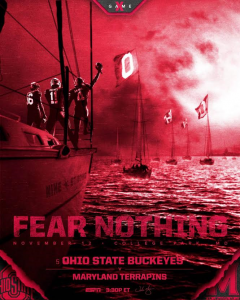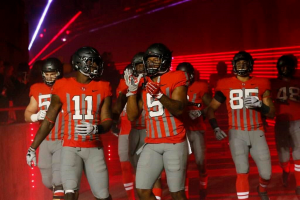Mayor Jim Watson Speaks: Promoting Importance of 2017 Outdoor Game to Melnyk
T6S via our good friends at Buckeye Battle Cry
Visit their fantastic blog and read the full article (and so much more) here
On the heels of Heritage Minister Melanie Joly’s announcement that the federal government had nixed the idea of holding an outdoor game in December of 2017 on Parliament Hill, Ottawa mayor Jim Watson met with the Ottawa Senators yesterday to articulate the importance of hosting a game in 2017 to commemorate a number of anniversaries.
The importance of a game obviously wouldn’t be lost on Eugene Melnyk or the Senators organization, but after the Parliament Hill proposal fell through, rumours of the Melnyk’s reluctance to use OSEG’s TD Place as a venue began circulating and Watson addressed those rumblings in an interview that he had today with the hosts of
TSN 1200’s ‘TGOR’.
To listen to the full interview, you can use the embedded media player at the bottom of this post, but Watson’s comments have been transcribed below.
As always, my thoughts are in
bold.
On whether his meeting regarding Ottawa hosting an outdoor game happened yesterday…
“It did, yes. It was yesterday afternoon and you’re quite right, we had to cut it a little short because of the challenge we had in the tunnel with the three workers and I was on site there. So we did have the meeting with Eugene Melnyk here at City Hall and I thought it was a very positive meeting. I laid out my vision for 2017 and all the work that we’ve been doing to attract a lot of really great events – the Grey Cup, the Canadian Figure Skating Championships, the Roar of the Rings and literally dozens of other events. And I’ve said, we’ve always maintained that we wanted to get three really big events: the Juno Awards – which we’ve now secured; the Grey Cup – which we’ve secured; and an Outdoor Classic. As you know, we worked very closely with the federal government because the ideal site obviously, the most iconic site to have an Outdoor Classic would be on Parliament Hill with the Peace Tower in the background. I’m not going to criticize or dump on the feds. They had some legitimate concerns from security to logistics to costs to the time that it would take to put 30,000 seats on the front lawn and so that decision was made about a week or so ago and conveyed publicly and to me. My view is that as Mayor, it’s my job to try to make sure that we have a game outdoors because as you both know, and many of your listeners know, Ottawa was the place where the very first NHL game took place in December of 1917 between the Canadiens and the Senators. And that’s why I’ve almost been obsessed with working to try and get an Outdoor Classic to end our 2017 celebration with such a significant anniversary – the 100th anniversary of the first NHL game in Ottawa, the 125th anniversary of Lord Stanley giving the (Stanley Cup), the 150th anniversary of confederation, the 50th anniversary of the (Ottawa) 67’s and the 25th anniversary of the Ottawa Senators. So when the (Parliament) Hill option was closed, I thought the most realistic and logical idea would be to have it at TD Place because the extra seats are already going to be up for the Grey Cup. We just keep them up a little bit longer. We have all of the amenities, restaurants, liquor licences, the Aberdeen Pavilion was where the Senators won one of their Stanley Cups in the 1920’s, it’s right beside the world heritage Rideau Canal, we have a transportation plan in place and that was my pitch to Eugene Melnyk and his colleague. And I came back from that meeting cautiously optimistic that I think I laid out exactly why we would like to have the game and Mr. Melnyk is going to give some thought to that and get back to us as soon as possible.”
L
ogistically, a game on Parliament Hill was always considered a longshot because of the timelines and circumstances involved. Whether those concerns could ever be overcome for the Senators to host a game there in the future remains to be seen, but realistically, it always felt like TD Place was the natural choice for where a prospective outdoor game would be held.
Now obviously it is a bit of a letdown knowing that the pipe dream scenario was dead in the water, but it’s hard to imagine that the Senators would let the opportunity to host an outdoor game in 2017 go by the wayside simply because their iconic idea didn’t unfold the way they wanted.
Then again, that Mayor Watson even felt it was necessary to meet with Melnyk and outline the importance of hosting an outdoor game in 2017 and play up using an alternative site like TD Place is pretty incredible.
Keep in mind, after the organization was spurned by the respective levels of government when it sought City support for an MLS stadium and the construction of a casino on property adjacent to the Canadian Tire Centre, Senators president Cyril Leeder stepped down from several economic development roles connected to the City of Ottawa in 2013.
On what the issue is for the Senators being hesitant to use TD Place and whether it’s an issue of the two sides not liking one another…
“No, I think there’s probably perhaps a little bit of rivalry because they are competitors, to be honest. TD Place is trying to attract concerts and big events for their venue and so is the Canadian Tire Centre. But, I think Eugene (Melnyk) recognizes that this is a decision that he can make and that the owner of the Montreal Canadiens can make. It’s not a league decision. I spoke with the commissioner Gary Bettman, I guess, two weeks ago and he said, ‘At the end of the day, you need the two owners agree.’ I think it’s a big decision. I think he was disappointed and a lot of people were that it wasn’t going to be on (Parliament) Hill and he didn’t want to just have another run of the mill stadium game. But, my pitch to him is that this is a once in a lifetime opportunity to celebrate the 100th anniversary, the centennial (anniversary), of the very first NHL game that took place in our own city back in December of 1917. As politicians like to say, I was cautiously optimistic that my message got through and Eugene was gracious with his time. We talked a lot about the franchise and the team and so on. I think he understands how important this is to the citizens of Ottawa to have this kind of outdoor game.”
Okay, I was hoping that the hesitancy to use TD Place would be more of a league decision in the sense that they’d be hesitant to award an outdoor game simply because it lacks the kind of flair that an iconic Parliament Hill game would generate, but if Watson’s right and it’s simply a matter of the two respective NHL owners reaching an agreement on hosting a game, what’s the problem here?
The Senators already do an incredible amount of work within the community and the organization should be commended for its charity work, the programs it funds and the initiatives it takes part in.
Keeping that in mind, it feels weird knowing that the organization could balk at hosting an outdoor game simply because their initial grandiose plan fell through or because they’re unwilling to cooperate with OSEG.
On whether he would characterize Eugene Melnyk’s reluctance to host this game on how the revenues from such a game would be split or whether the reluctance is attributed to it being held at a less iconic venue …
“Well as I understand it, basically the league takes the revenue for outdoor games. So it’s not a money-maker for the Senators from that perspective. They obviously, if the game was held at the Canadian Tire Centre, they would reap the benefits from parking and concessions, I assume. Whereas at Lansdowne, depending on what agreement is reached, you would assume that Lansdowne and OSEG would keep the revenue from concessions and from the parking, but the Sens would probably… obviously… and the league more importantly would keep the revenue from advertising and ticket sales. And ticket sales would be several million dollars because you’re looking at a fairly high price. But I think the other thing is, having this as part of a package, I think will help season ticket sales for next year as well. If you can market and advertise the fact that you’re going to get an Outdoor Classic – which is the 100th anniversary of the first NHL game in the history of the world that took place right in our backyard – that’s a pretty strong selling point too. Eugene said all along and his people said all along, they focused entirely on (Parliament) Hill because they didn’t want to take their eye off that ball because they felt (Parliament) Hill would be international (news) all over the world and I agree with that. There’s never been an NHL game played in a venue like Parliament Hill, so there’s no question that there’s disappointment on that. But, we can’t reverse the hands of time. The government’s made that decision. My ultimate goal is to make sure we don’t lose the real opportunity to have that outdoor game between the Habs and Senators in December, 2017.”
I’ll come back to the point about the league taking revenue from the game, but again, for Watson to believe that it’s necessary to play up the importance of hosting this game in 2017 is pretty incredible.
On TD Place being a much easier location to hold the game…
“The infrastructure is there. Everything from locker rooms to the issue of selling alcohol on the front lawn of Parliament Hill and so on – there were a lot of obstacles (to put a game on Parliament Hill) and to be fair to the federal government and to both the NHL and the Senators, they went into these negotiations with a lot of good will. They didn’t string them along, but there are a lot of people in charge of Parliament Hill and I’ve always said, ‘It’s one of these areas (where) everyone is in charge, but no one is in charge.’ You have the Speaker of the House, the Speaker of the Senate, RCMP, there’s a committee for the use of Parliament Hill, there’s the Department of Canadian Heritage and the Department of Public Works. We had an event there to welcome this conference ‘One Young World’ and it took us a long time to get permission to get a stage and the Prime Minister was even coming and it took a while. So, to put up 30,000 seats or 25,000 seats and to build the infrastructure that would be required and the security, I think they just felt that it was just not feasible. That’s why I’ve pivoted, if you will, to ‘Let’s see what we can do about TD Place’ because as you’ve pointed out, it’s got the infrastructure in place already – everything from dressing rooms to concessions to liquor licenses. You could have a great fan fair at the Aberdeen Pavilion. If the weather was right, I could see people skating to the game from downtown or from other parts of the (Rideau) Canal, so it would be pretty exciting to have it there.”
Skating on the Canal in December? That may be more ambitious than hosting a game on Parliament Hill.
On whether there are challenges to hosting it at TD Place and who pays for the game to happen…
“That would be the NHL. They have the rink and the expertise. Eugene and I were talking about when (the NHL) takes on a project like this, it’s done so well and so professionally, it’s really top drawer. I’ve met with the commissioner a couple of times and he certainly knows – I think he’s probably tired of having me speak to him about this – but he knows how important this is to the city to get this game. There was a lot of excitement when it was announced that we were looking at attracting an NHL outdoor game. I don’t think the novelty’s worn off. I think the very fact that it’s never been held here and we also have that historical note of the first game. I could see the Canadiens coming in old school jerseys taking the train up from Montreal and turning it into a real event and not just (emphasizing) the game but the week leading up to it.”
Based off what Watson is saying, an outdoor game means:
- The league takes the revenue generated from the game
- The league also pays for the associated costs to put it on
- The game would take place simply if the respective owners of the Canadiens and Senators can reach an agreement
- The citizens of Ottawa and fans of both franchises would benefit greatly
If the league takes the revenue and pays for the associated costs, what’s the hold up?
This shouldn’t be a hard sell where the Mayor feels it necessary to meet with Melnyk because he’s worried about this opportunity being lost.
Just fucking get it done.
On if the TD Place option falls through and whether an alternative location like LeBreton Flats could be used and what kind of drop dead date is there to reach an agreement on hosting a game…
“Well, I think we’ve all agreed and the league as well that we have to have a final decision and a deal signed by at the latest mid-January and that’s really at the latest. In terms of LeBreton Flats, I think you run into the same cost problems with respect to (Parliament) Hill. You were looking at a significant amount of money to put bleachers, temporary bleachers, up on (Parliament) Hill. I don’t think LeBreton is that realistic of an option. It’s an open field, which is great, but if you know Bluesfest, they have stages and really that’s it. There’s no seating. Everyone sits on the ground or brings a lawn chair, so I think Lansdowne makes the most sense.”
Hey, the Senators have a history for finding homes where open fields used to be.
http://proxy.autopod.ca/podcasts/chum/1/47762/mayor watson.mp3
 Continue reading...
Continue reading...











